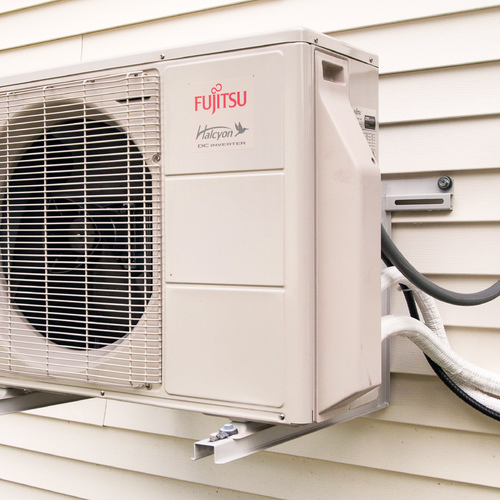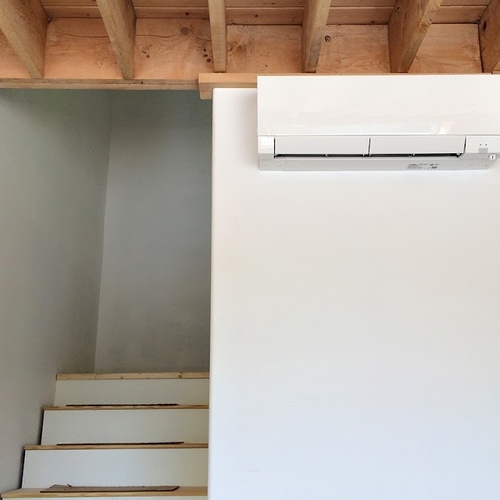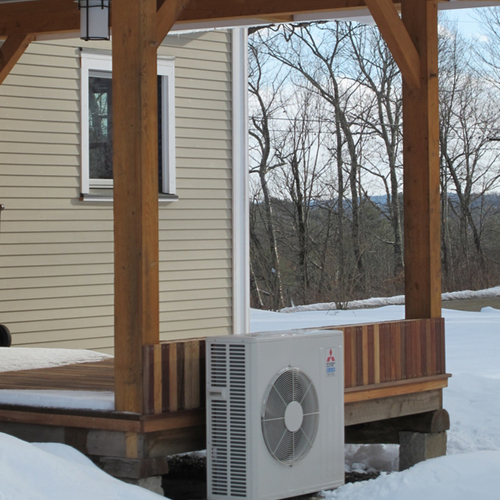Image Credit: Friedrich
Image Credit: Friedrich The Breeze outdoor compressor is capable of producing heat when the outdoor temperature is as low as 17°F. Friedrich is offering the units in two sizes. Designed for simple connection. Inside and outside units are connected with this snap fitting. The electrical connection also is a quick connect.
UPDATED on May 14, 2014
Friedrich is launching a ductless minisplit heat pump designed for installation by a homeowner with only modest mechanical skills and no professional HVAC training.
Ductless minisplits are high-efficiency air conditioners and heaters that include an outdoor compressor and an indoor fan unit, typically mounted on a wall. They’re usually sized and installed by professionals, partly because of the heat gain and loss calculations required to choose the right unit and partly because indoor and outdoor components are connected by electrical, condensate and refrigerant lines that may be difficult for a non-pro to handle.
Friedrich hopes its Breeze heat pump kits will help homeowners navigate those problems without the help of a professional installer. The San Antonio, Texas, company says the unit is available nationally.
Just two sizes to choose from
Heating and cooling professionals normally run Manual J calculations before choosing a specific piece of equipment to make sure its output matches the heating and cooling loads in a particular space. But Friedrich is offering only two models of the Breeze, one for spaces up to 500 square feet and another for spaces up to 1,600 square feet.
The company says its inverter-equipped motors, the same technology used by minisplit pioneers like Fujitsu and Mitsubishi, helps the unit reach its set point quickly and hold it more efficiently than conventional equipment.
After choosing either a large or small capacity unit, the only other decision installers will have to make is whether to run the modular connecting line through a 3-inch hole in the wall behind the fan unit, or through an accessory that sits in the bottom of a window opening. Through-the-wall installations are hidden when installation is complete.
The connecting line comes with a quick-connect fitting allowing it to be snapped into place without tools, according to Friedrich. The compressor also has snap-in electrical connectors.
The whole process is covered in an 8-minute YouTube video.
The smaller of the two units has a maximum cooling output of 12,000 BTU/h and produces 7,000 BTU/h of heat when the outdoor temperature is at 17°F (11,000 BTU/h at 47°F). It runs on 115 volts AC. The large unit has a maximum cooling output of 24,000 BTU/h and produces 14,200 BTU/h at 17°F (22,0000 Btu at 47°F). It requires 230 volts AC.
The units cost from about $2,000 to $2,500.
Update: On May 14, 2014, Friedrich announched that the company is limiting sales of the Breeze. The company announced, “Friedrich has intentionally rolled out the product with limited production for sale only in New York and South Florida. While Friedrich wanted broader exposure this summer season, the company has decided to pull back to avoid creating demand that Friedrich cannot deliver on. Friedrich is currently reviewing its broad launch date with its retailers and production team.” For more information, see Friedrich Pulls Back on DIY Minisplit Launch.
Weekly Newsletter
Get building science and energy efficiency advice, plus special offers, in your inbox.
















15 Comments
line set
How do they get around not being able to vacuum the line set?
Obviously both units should be clean and dry and the line set should be too but it will still have air in it....
a lot missing
Along with the vacuuming issue, they have a bit of a chicken-and-egg
problem around proper sealing of the lineset hole in the wall and
the video glosses over a lot of things that make someone with even
a modicum of HVAC awareness go "waitasec! what about ..." And they
could have at least leveled the ground under the pad a little...
It looks like they also take the outdoor-unit side of the lines
through generous S-bends of thin tubing before the service valves,
likely to allow for plenty of amateur wanking on the connection
point without bending something critical. One would probably want
to better insulate those areas somehow...
If that lineset quick-connect thing actually works and can remain
leakproof long-term, though, that's huge. No more brazing or
flares to screw up, which is all too common. Is that any kind of
industry-standard connector or something Friedrich developed??
Interesting, but raises a lot of questions. I wonder where it's
manufactured...
_H*
Could be Great, Could be a Disaster
This approach could be great for a serious DIY person who really does their homework. Could be a disaster for someone who installs just based on the ridiculous "two-sizes-fit-all" approach. Those size ranges are practically meaningless. Someone has to do some fairly serious heat/cool load calculations.
Scott, in my experience, you shouldn't be telling people that "Heating and cooling professionals normally run Manual J calculations before choosing a specific piece of equipment to make sure its output matches the heating and cooling loads in a particular space." That's funny. When I had minisplits installed at my house, I had several HVAC pros come out to do an estimate. When I asked then about doing Manual J calcs, they all said something like, "ah, do you really want me to charge extra for that considerable amount of work."
No, HVAC pros don't do Manual J, at least not very often. They do what they all did at my house and that is, they look at the size and vintage of a house and guestimate based on their considerable experience. I knew this ahead of the time of my minisplit installation, and I also knew my loads based on running both Energy Plus and BEopt, so I played around with the HVAC guys a little. They all said I needed 2.5-3 tons worth of minisplits (easy for them to say that, since my existing central heat pump was 3 tons, and the whole neighborhood full of similar houses have 3 tons). What they didn't initially know was that I had done an extensive energy retrofit---layers of rigid foam added for R-40 walls, infiltration tightening, R70 attic, R20 rigid insulation all around the frost wall all the way to the footers, new U=.15 windows all around, etc. They all ended up pretty well astonished, but finally just quoted a price for minisplits to meet the load that I had calculated myself. The HVAC contractor I actually selected put a disclaimer right in his written quote that said something like: "home owner selected the capacity of the minisplits--capacity will not be adequate and home will be uncomfortable." Hee, hee, I've been laughing ever since--the capacity has been more than adequate, summer and winter, even with 4-5F degree nights this winter, which is well under design temperature for my area.
Here's the point. A residential DIY person can definitely do a BETTER job than most HVAC pros, but you can't be a casual DIYer. The homework is not that hard, but you have to do it.
with respect to the Manual J,
with respect to the Manual J, I thought that one of the advantages of modern mini split heat pumps over most other forms of HVAC equipment is that they are efficient even when oversized-they can scale down efficiently. Thus, you can buy a unit thay is clearly oversized for the space and they will run at lower capacity just as efficiently as a smaller, more appropriately sized unit would run. Given that you are saving thousands of dollars over having a pro install a unit you would just do a back of the envelope calc and buy the larger unit (or several larger units).
The real issue here is(i) how efficient are these units (particularly in heat mode) versus the best Fugitsu or Mitsubishi, and (ii) what happens if they break down? Will the company back these with local HVAC delaers who will come out, troubleshoot and fix the problem?
No longer available already???
I contacted Friedrich today because this option looks awesome to me as a serious DIY with a serious botched HVAC system. This is the reply I received:
"Thank you for contacting Friedrich Air Conditioning. I do apologize, but I have to inform you that our Breeze units (the DIY install mini splits) are not available at this time. Unfortunately, there is not an ETA on when these units will be available again. If you have further questions, please call our Consumer Assistance Department at 1-800-541-6645 ext. 260 for further information."
I have not reached them by phone yet. What the heck?
more info on the kit
I did a little more research, including a call to Friedrich tech
support this morning. The lineset turns out be a non-issue --
both the condenser unit and the lineset / indoor coil are all
pre-charged, and the dual connector is a very fancy affair
that uses the insertion and locking movement to push internal
parts and open valves to make the refrigerant connection. They
claim this is a really reliable connection, without any customer
complaints of leakage in the 3+ years they've been producing
these things. Apparently you can do some modest number of
connect/disconnect cycles without losing significant amounts
of refrigerant, and there's always the option of having a pro
vacuum and weigh in a new charge if needed.
He didn't happen to know the patent or application number, or
I would have read up on the details by now...
Both connections in the lineset handle the low-pressure side,
i.e. the expansion valve is in the outdoor unit so in either
heating or cooling, all the 350+ PSI high pressure flow is
contained inside the condenser box. [Edit: upon further
reflection that can't possibly be 100% true, or heating mode
wouldn't work at all.] Meaning it's even more important to
not compromise the lineset insulation going into the house.
The guy agreed with my suggestion that the externally visible
S-bend in the tubing before it goes into the outdoor unit
should probably get insulated too. The bend is basically to
absorb any remaining vibration.
There are other kinds of refrigerant "quick connect" fittings,
many of them one-use only as they physically break internal seals
in the hookup process but don't need to be brazed or flared. The
industry seems to mistrust any type of quick-connect as they have
some history of unreliability, but that seems to be less of an
issue now.
_H*
Not for cold climates
Very interesting concept, but wanted to find out if they can do low temps like Mitsubishi and Fujitsu. They can't. This is what a rep said when I emailed: Our Breeze unit operates in heating mode for temperatures between 19.4° F - 75.2° F. For cooling mode the unit will operate between the temperatures of 64.4° F – 109.4° F.
Response to Sean Botham
Sean,
These units have been tested and rated at an outdoor temperature of 17 degrees F, as reported in the article, so we know they function at that temperature (which is lower than the range you quote).
Since the heating capacity at 17 degrees is pretty good, I would expect them to work when it is even colder outdoors, although at a lower capacity and a lower efficiency.
And speaking of said heating efficiency...
....a nameplate HSPF of 7.8 and SEER of 17.5 while legal, isn't anything to crow about these days for a unit that costs $2K for 1-ton.
That's quite a bit lower than a 1-ton LG with an HSPF of 11, SEER of 20 and a rated output at +5F can be had from web-stores for ~$1100-1300, leaving ~$700 or more on the table for tech-time to do the final refrigerant charging & test after a mostly-DIY installation.
http://s3.supplyhouse.com/product_files/LSU121HSV-submittal.pdf
That's 40% more heat per kwh, at a comparable (or even lower) installed price.
The cheapest web-store discount price on the 1-ton Breeze I've encountered is still $1600. I'm not sure the ability for 100% DIY installation is a sufficient value-add, but maybe.
To be sure the 1 ton mini-split market is VERY competitive!
World-wide the pre-charged linesets & DIY installation approach is probably at least as common as those that require equipment for post-charging. There many parts of the developing world where refrigeration techs are rare, and family budgets wouldn't be able to afford them anyway, even though they can a afford a DIY type low-end mini-split. The same lower-cost lower-efficiency units are available in the US, for those to whom first-cost takes precedence.
$700 isn't enough for the install
$700 for a minisplit install? No way. Ok, I'm mixing apples and oranges a bit. For straight installation with an existing electrical connection, I've been quoted $1200 as my lowest price for a mini split installation and that was something of a shady provider. Up to $1500 isn't atypical. Yes, it seems like the $700 might cover just charging it but I'm not finding providers in my area who are willing to do that.
Not to always be the retrofit voice here, but I'm currently running a seer 10 older mini split. I'd love to replace it. Seer 17.5 would be great.
Additionally, the price of equipment often drops over time. The price of labor almost never does. So this concept, a DIY a/c install, could drop in price over time. Think of all the SEER 7 or 8 window units that could be replaced in a given weekend if the price of a mini split install dropped by eliminating the labor.
Besides all the technical details,
there's another concern: aesthetics. Who wants to put something like that up on a wall, and then have a long power cord hanging down and plugged into a socket? Let's face it: it's ugly. Does "ugly" sell? Not where I live. On to the next bright idea...
Minisplits are typically hardwired
Gordon, Maybe the Breeze is different but mini splits are typically hardwired. The blower unit is wired to the condensor's power disconnect. It's not for the casual DIYer. So you don't see a power cord. Also, in the retrofit market, a mini split is competing with a window unit (ugly, leaky, loud, inefficient, blocks a window) or a portable unit (ugly, takes up a lot of space, loud, inefficient, blocks a window). The breeze doesn't offer the option but as I'm guessing you know that mini splits in general offer 'blower' form factors that include concealed ducted units, suspended ceiling units, wall blowers, and ceiling cassette (which are sized to fit in drop ceilings).
In a practical sense, it is
In a practical sense, it is very difficult to find an HVAC pro willing to put in a unit purchased online. In New Jersey by the time you pay for labor, a markup and all the ancillary parts, the installation of a high quality mini split like a Fugi ot Mitsu is very expensive, particularly if you choose several high efficiency single units instead of one mulit unit. It is not unusual to find quotes of $15,000+ for a medium sized house around here to do it right. That is the primary reason why they have not caught on as they should have given the great technology.
Keith H,
I only said that because in the installation video the unit is clearly shown being plugged into a wall outlet, with a white cord hanging down and going into a socket. If I saw incorrectly, I apologize. Of course I know that mini-splits are hard-wired.
Gordon: my apologies
After they told me by email, that these units are no longer available (??), I didn't watch their documentation. While I have hard wiring a blower unit in my skill set, I suppose that was an invalid assumption about the average DIYer electrical abilities.
Log in or create an account to post a comment.
Sign up Log in